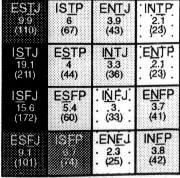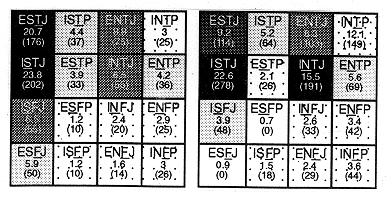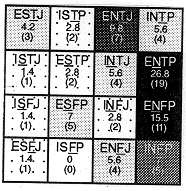 David Durling, David Durling, Edge Ltd., P.O. Box 65, Hartlepool, Cleveland, TS25 OYH, UK.
Edge Ltd., P.O. Box 65, Hartlepool, Cleveland, TS25 OYH, UK.
Abstract
We sometimes talk of putting personality into products. Similarly, human-computer interfaces might be imbued with personality. But what is meant by personality, and can it be measured in ways that can be computed? One approach is to investigate the personalities of designers themselves. Jung's Theory of Psychological Types is used as a framework for understanding cognitive differences, manifest in styles of personality, between designers and other professional groups with which they might be expected to come into contact in a working situation. A survey of UK design undergraduates was undertaken. Designers are typically shown to be highly intuitive and analytical. This is combined with an open-ended curiosity about their world. They are similar to cognate professionals such as architects, but significantly different to business managers, engineers, computer specialists, and a general population.
Individual preferences for information and media can be associated with personality types. This is shown to have considerable implications for, among other things, teaching and learning through multimedia. Students suffer cognitive dissonance when teaching and learning are mismatched. Therefore technology and business studies, for example, are likely to be taught in styles which are inappropriate for the majority of design students. It follows that computable models of personality can play a part in the design of adaptive interfaces which seek to provide a better cognitive fit between computer and human user. Otherwise, whatever personality or style Is put Into products will be a mirror of the designer's own personality, and therefore be less suitable for the majority of users.
Virtual personalities
If it is possible for designers to put personality into products or into human-machine interfaces in general, it is likely to be components of their own personalities. One approach to understanding personality in such interfaces is to use quantitative methods to measure the personality of designers. We can then see how designers differ from others. What do we know of designer personality? A major component is creativity. Unlike scientific originality, artistic creativity is not connected with intelligence as measured by conventional IQ tests. Designers' creativity seems to be linked to a number of factors. INTUITION is thought to play a dominant part. Highly creative designers report that they know when an idea is the right one [1]. Problem-solving is associated with highly divergent thinking coupled with a certain playfulness. Designers will tolerate much uncertainty, and are happy to just try solutions instead of slavishly following methods [2]. In this respect they exhibit risk-taking, and there is an openness to experience. There may be some rebelliousness towards tradition, and there may also be unconventionality, often with marked independence. It is thought that brain lateralisation is a factor: designers seem to be right brain-hemisphere dominant, and this may be seen in a higher incidence of left-handedness.
Right-brain thinking is characterised by a distinct holistic, visuo-spatial approach which is high on imagery. This contrasts sharply with the more convergent, analytical approach which is typical of science and technology [3].
Personality inventories seek to measure underlying cognitive characteristics, the outward manifestation of which is termed 'personality'. A Theory of Psychological Types was first proposed by the Swiss psychiatrist Carl Jung [4]. He stated that individuals exhibit stable and predictable preferences in the ways they use their minds, and that these differences influence the ways they like to work, what motivates them, and what satisfies them. As soon as children exercise a preference for one mode or the other, their development is towards the preferential enjoyment of the one mode. Jung's theory is operationalised in the Myers-Briggs Type Indicator (MBTI). It measures preference strengths which reflect the kinds of perceptions and judgements individuals use in interacting with their environment, thereby exposing constructive differences between people [5]. A central philosophy of the MBTI is that all types are equal.
The MBTI is arranged as a set of 4 dichotomised scales. The four scales provide a total of 16 types denoted by a four character label. For example, an EXTRAVERSION-SENSING-THINKING JUDGEMENT type would be labelled ESTJ.
Orientation
Processes
Attitudes
The interaction of the Jungian scales lends to each type a number of significant characteristics [6].
Individuals in many occupations tend to cluster in certain types or groups of types [6]. Some examples are shown below. In an effort to visualise the data more easily, a darker tone denotes more individuals in that particular group; each box shows the type (with the dominant process underscored), the percentage of persons in that type, and the numbers of persons in parentheses. Firstly, data are shown which relate to a random sample of population. This is used here as an indication of a normalpopulation for comparative purposes.
 It will be noted that there is an uneven distribution of type. Over three quarters are SENSING types. Two thirds prefer JUDGEMENT.
In order to demonstrate the clustering of some occupations, two examples are given of professions with which designers might be expected to come into working contact. On the left, business managers are mostly SENSING; strongly THINKING; and strongly JUDGEMENT. Objectivity, logical analysis, and dealing with facts are the dominant traits in business managers, and this is combined with a decisive attitude.
On the right, computer professionals are strongly THINKING; and mostly JUDGEMENT. The analytical THINKING mode again dominates (only more so) and is combined mostly within a decisive attitude.
 In order to obtain quantitative data for where typical UK designer are situated within the MBTI matrix, a study of design undergraduates was undertaken in the Spring term of 1995. A total of 71 students were assessed. The subject specialisms covered were product design; interior design; graphic design; and furniture design. It will be noted that INTUITION is preferred by these individuals, and is mainly combined with THINKING . They also markedly prefer PERCEPTION. The characteristics of designers are therefore an open ended attitude which relies mainly on INTUITION, and these are combined with an EXTRAVERSION orientation which is comfortable in working with others.
The designers surveyed here show similar characteristics to other kinds of designers such as architects and interior design majors in the USA [7]. Fine artists have broadly similar characteristics, though they show more preference for FEELING.
 The intuitive, future oriented, seeking of possibilities are shared characteristics among creative groups. Similarly to architects, THINKING is favoured by designers who, perhaps connected with the world of products and technology, have use of the analytical and logical processes which the THINKING mode brings. A large number of designers favour the PERCEPTION way of relating to the outer world. They prefer to keep their options open, and to be flexible and spontaneous. INTUITION and the PERCEPTION attitude account for over half of the designer sample. These traits lead them to be open-ended and curious about their world. Designers are therefore significantly different to many non-design professionals. They are quite different to a general population.
But how can these data be utilised in adding personality to physical or virtual products? Firstly, there are implications for the teaching and learning of design. Teachers shape educational materials to reflect their own particular interests and viewpoints, thereby authoring in particular styles. There is evidence that where the style of teaching mismatches the learner's own style, cognitive dissonance occurs and understanding is diminished [8, 9]. If the style of educational multimedia reflects the personal style of its creator, cognitive dissonance will be caused in learners with different or opposing styles.
If learners find their human tutors disconcerting, they may find computer-based tutors quite disconcerting or hostile. Computable models of personality can play a part in the design of adaptive interfaces which seek to provide a better cognitive fit between virtual tutor and human learner. Such models may also find their way into the interface between users and products which, on the surface seem as though they should be simple to operate, but are difficult to control. Examples of such products will include the notorious VCR, and perhaps the answering machine. Both utilise time-based media and, in terms of how they are controlled by a user, both seem to operate on the machine's own terms rather than working as (most) users naturally work. These problems will increase as computers become embedded in products and more transparent. A better analysis and use of aspects of personality may yet lead to more comprehensive and quantitative interface design, and a better cognitive fit between products and (many) human users.
References
1] Davies, R. & Talbot, R. (1987) Experiencing ideas; identity, insight and the imago. In: Design studies Vol. 8, No.1, pp.1725.
[2] Lawson, B. (1990) How Designers Think. 2nd Edition, Butterworth Architecture.
[3] Bogen, J. (1969) The other side of the brain 11: An appositional mind. In: Bulletin of the Los Angeles Neurological Society, Vol. 34, No. 3,1969, pp135-162.
l4] Myers, l. & Myers, P. (1980) Gifts Differing. Consulting Psychologists Press, Palo Alto, CA.
[5] Myers,l.B. (1993) Introduction to type. (fifth ed..) Oxford Psychologists Press, UK.
[6] Macdaid, G.P., McCaulley, M.H. & Kainz, R.l. (1986) The Myers Briggs Type Indicator: Atlas of Type Tables. Center for Applications of Psychological Type, P.O. Box 13807, Gainesville, Florida 32604, USA.
[7] Diehl, J.L. (1992) The relationship between creativity. imagery. and personality types in interior design students. Doctoral dissertation, Oklahoma State University. University Microfilms International, 1993, 93-21561
[8] Festinger, L. (1957) A theory of cognitive dissonance. reissued by Stanford university press in 1962.
[9] Parlett, M. & Simons, H. et al. (1988) Learning from learners: A study of the student's experience of academic life. In: SCED. Paper 54.
For more SYNDICATE SPEAKERS For other SYNDICATES |